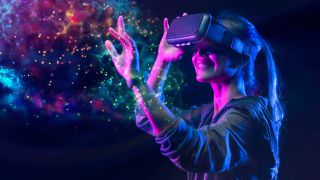Virtual reality, or VR, is a digital world that was developed decades ago but has come into its own in recent years. This is because only now is the technology small enough, powerful enough, and affordable enough to reach the mainstream. For those reasons, virtual reality is now starting to get used in education.
VR represents a new media platform that can allow for a more immersive way for students to learn. But, importantly, it can also be an option to offer greater opportunities and experiences to all students.
For example, students in positions of physical limitations, or schools with limited funding, are now able to experience virtual trips to real places they could not have reached before.
Read on to find out all you need to know about virtual reality in education.

What is Virtual Reality?
Virtual reality (VR) is a computer-based system that uses software, screens on each eye, and interactive controls to allow a person to enter a virtual, digital world. It can also be achieved using tablets and smartphones with the screen as the virtual world, but this is a less immersive way and often applies to augmented rather than virtual reality.
By placing the displays close to the eyes, usually in a headset, it allows the person to feel as if they're looking at a giant screen, close-up. The makes for a very immersive view that is coupled with motion sensors so when you move your head the view changes, just as in the physical world.
While virtual reality has been used widely for gaming it's also now being used in work-based training and, more recently, in education. One of the big factors in this relatively recent uptake was Google Cardboard, which used a super affordable cardboard phone holder with lenses built in to create virtual worlds. This works with smartphones, allowing students and teachers to easily and affordably experience VR.
Since then, virtual reality has had lots of funding thrown at it by big name companies, universities, and technology brands. With a global value at $6.37 billion back in 2021, which should reach $32.94 billion in 2026, it's clear this is a fast-growing area that's going to mean big changes in education long term.

How can virtual reality be used in education?
One of the most powerful ways to show off virtual reality in schools is to take virtual tours. This can mean visiting a location, anywhere in the world, without the usual issues of cost, transport, waiver forms, and even crowds to worry about. Instead, students and teachers can slip on VR headsets and all go on a tour together. But it goes further as this can also go beyond time, allowing a class to go back and visit an ancient city that's now gone, for example.
The uses for VR extend into a variety of subjects, however, for science, for example, students could visit the stars or carry out virtual lab experiments safely using digital versions of the real thing but that react in the same way.
This goes further with some schools actually setting up virtual classrooms that children can visit remotely. The Optima Academy charter school in Florida provides its 1,300 students with Oculus VR headsets to participate in virtual lessons. This can include history lessons taught in the Oval Office, virtually, or among the planets for astronomy.

How can schools get virtual reality?
Getting virtual reality into schools consists of two main parts: the access to virtual reality headsets themselves and the software required to run it all. There are now companies that specialize in providing kits with enough headsets for an entire class. Most also now have their own software, compatible with others, which allows teachers to manage the experience of the class and gain access to lots of educational apps and games.
There are also apps that offer virtual reality experiences on phones and tablets without the need for a headset. Think Google Earth, in which you can explore the planet virtually by panning and zooming about. That's not as immersive, but certainly classes as a virtual reality experience.
Since Apple introduced software advances that make building virtual reality easier this has grown massively in education. One leading name is Discovery Education, who offers a good example of augmented reality with their new app that was featured at Bett 2022.
We've also compiled a list of the best virtual and augmented reality headsets for schools, which shows the options out there and can give you an idea of pricing.

